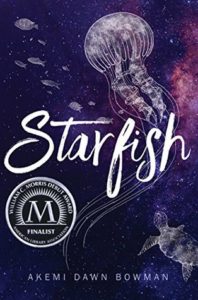
Starfish
Akemi Dawn Bowman
Simon Pulse
Published September 26, 2017
Amazon | Barnes & Noble | Goodreads
About STARFISH
A half-Japanese teen grapples with social anxiety and her narcissist mother in the wake of a crushing rejection from art school in this debut novel.
Kiko Himura has always had a hard time saying exactly what she’s thinking. With a mother who makes her feel unremarkable and a half-Japanese heritage she doesn’t quite understand, Kiko prefers to keep her head down, certain that once she makes it into her dream art school, Prism, her real life will begin.
But then Kiko doesn’t get into Prism, at the same time her abusive uncle moves back in with her family. So when she receives an invitation from her childhood friend to leave her small town and tour art schools on the west coast, Kiko jumps at the opportunity in spite of the anxieties and fears that attempt to hold her back. And now that she is finally free to be her own person outside the constricting walls of her home life, Kiko learns life-changing truths about herself, her past, and how to be brave.
From debut author Akemi Dawn Bowman comes a luminous, heartbreaking story of identity, family, and the beauty that emerges when we embrace our true selves.
A William C. Morris Award Finalist; A New York Public Library Best Book for Teens of 2017; A Junior Library Guild Selection
My Review
I’m a total sucker for books about an artist– and STARFISH absolutely scratched that itch for me. I loved the way descriptions of Kiko’s drawings ended every chapter, and the way the disconnect between her sketches and her paintings played such an important role in the story.
Mom issues are harder for me to read. Maybe because I am a mom? Maybe because they make me want to jump into a book and slap someone. Kiko’s relationship with her mom causes her a lot of self-hate and shame.
When Kiko goes to California, she finally begins looking at her life through eyes that aren’t her mom’s. She discovers connections with her Japanese heritage and begins to dismantle the shame she learned to feel about the way she looked. I loved the emotional journey of STARFISH. I couldn’t help falling in love with Kiko– sweet, insecure, talented Kiko– and kept rooting for her all the way through the last page.
Fans of E. Katherine Kotaras or SISTER PACT by Stacie Ramey will love the focus on and healing power of art in STARFISH.
Recommended for Ages 14 up.
Representation
Kiko and her siblings are half-Japanese. She meets a Japanese man and his family.
Language Content
Extreme profanity once.
Sexual Content – Sexual Abuse Trigger Warning (And Spoiler)
Kissing between a boy and girl.
Early in STARFISH, Kiko goes to a party and a boy leads her into a bedroom. He forcibly kisses her, which she does not want him to do, but she freezes up and feels unable to stop him. Later, he asks her not to tell anyone that it happened, so she doesn’t.
Kiko’s rotten experience with men doesn’t stop there, though. She battles memories of abuse by a family member who touched her lower leg while masturbating in her bedroom in the middle of the night. She pretended to be asleep but told her mom, who refused to believe her.
Spiritual Content
None.
Violence – Suicide Trigger Warning
One character in STARFISH makes a suicide attempt. It happens off-scene, and we don’t learn the details of how it happened. Just a warning for sensitive readers that it’s in there.
Drug Content
Kiko goes to a party where teens drink alcohol. She feels pressured to drink with them, but a friend gets her a soda instead.